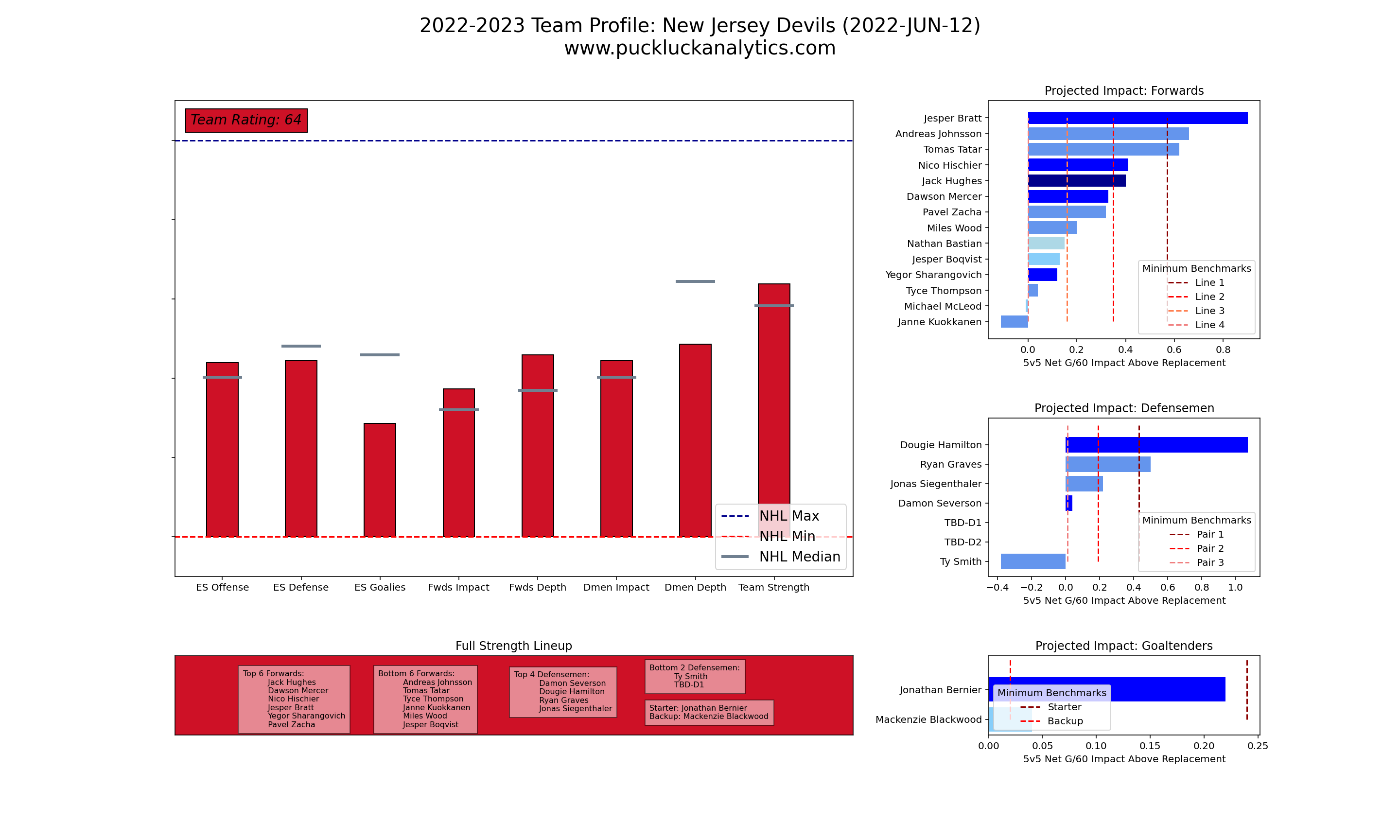The New York Rangers were the 14th casualty of the 2022 Stanley Cup Playoffs, falling to the Tampa Bay Lightning on Saturday night. With the loss, the 21/22 season is in the books for the entire Metropolitan Division and it was an interesting one. All 8 teams got off to strong starts and it took 10-20 games before we found out which teams would rise to the top. When we did finally see separation in the standings, it was dramatic, with the four playoff teams separating quickly and creating an insurmountable gap in the standings.
What’s in store for the Metropolitan Division in 22/23? Are the incumbent playoff teams the early favorites? Which teams have the most potential to improve this offseason? Which teams face difficult decision this summer due to their cap situations?
For the analysis below, we’ll make a few key assumptions. First, we’ll assume that all RFAs will return to their current clubs. Their impact is included in the team projections, however no cap hit is included in the team totals. Obviously, some of each team’s cap space will be required to resign their RFAs so we’ll make note of potential cap headaches where applicable. Second, all UFAs are removed from the rosters. Any resulting holes in the roster have been filled with replacement level players.
Metropolitan Division Projected Standings
With rosters adjusted as described above, the Metropolitan looks like a potential blood bath next season. It’s the most tightly grouped division in the early offseason projections and the summer looks like it could be a difference maker as a result. The Carolina Hurricanes are projected to top the division once again, with perennial contenders Pittsburgh Penguins and Washington Capitals close behind.
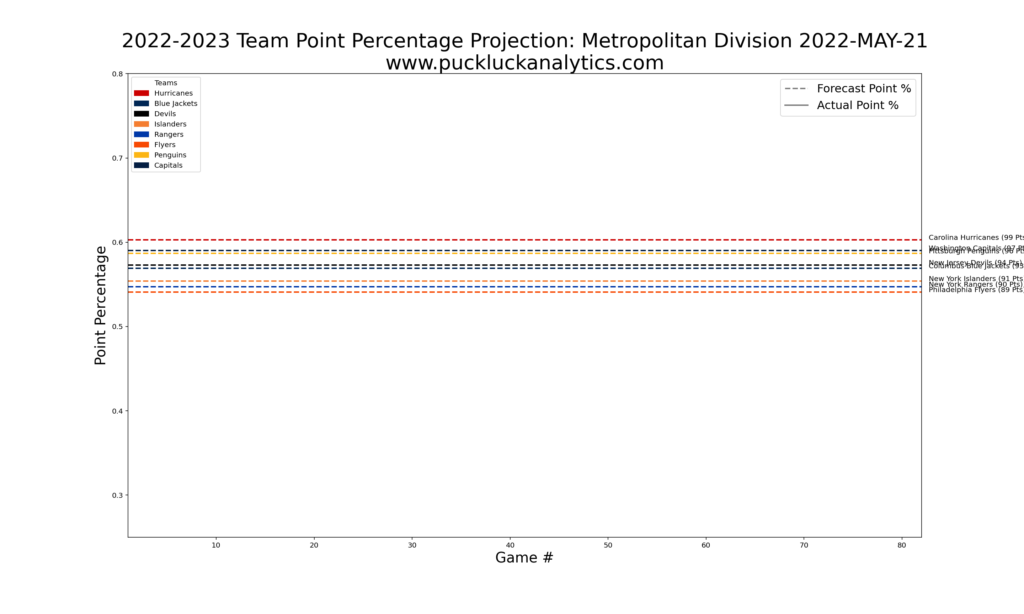
Obviously, the are plenty of decisions to be made by each team over the summer and offseason moves will change this outlook. Each team has a unique set of roster construction and cap space considerations as the offseason gets underway. How might the landscape change over the offseason? Let’s take a look at each team’s situation, in order of the current projected standings, to see which teams have the most potential to improve over the offseason.
Carolina Hurricanes
The Carolina Hurricanes took the first seed in the division in 21/22 and they are the early favorites to win the division next season. They have a well-rounded roster, with the strength of their defense corps and their even strength offense their biggest strengths. If there are areas to focus on improving this offseason, it’s the total impact of their forwards and their defensive depth.
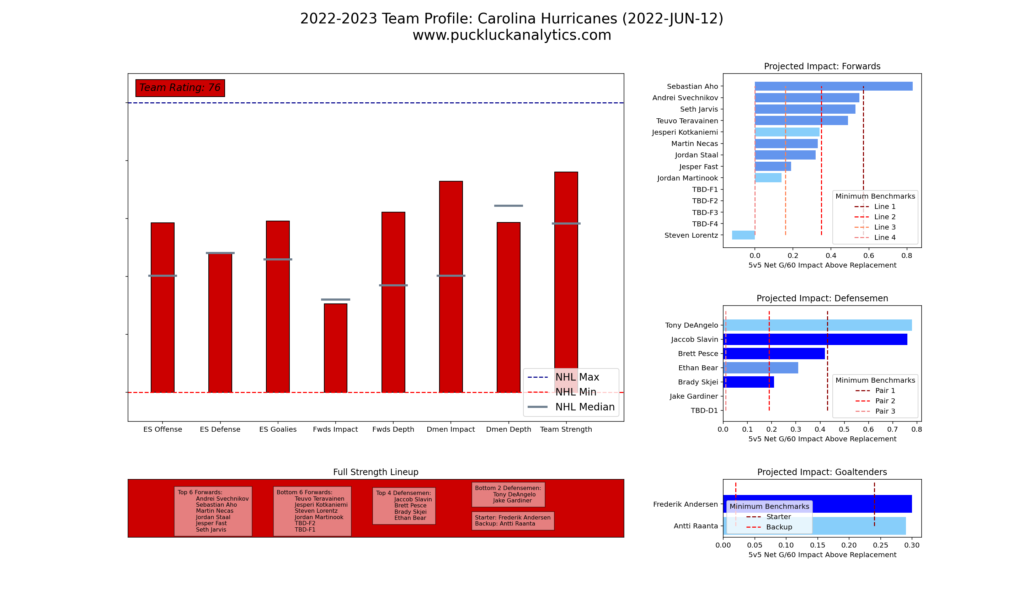
The Hurricanes enter the offseason with some key RFAs to extend. Marin Necas, Tony DeAngelo, Ethan Bear, and Steven Lorentz are all in need of new contracts and extending them all will eat into their $20M in available cap space. The Canes will still need to add five players if they bring all 4 RFAs back. The (potential) loss of UFAs Nino Neiderreiter, Max Domi, and Vincent Trocheck is the biggest reason the Hurricanes forward depth is below league average at this stage of the offseason and prioritizing the addition or return of a couple of top 6 forwards would help the Hurricanes improve before opening night.
The Hurricanes have flexibility with their roster and cap situation as they plan their 2022 offseason. With some smart moves, it seems quite probable that they can improve their roster over the summer.
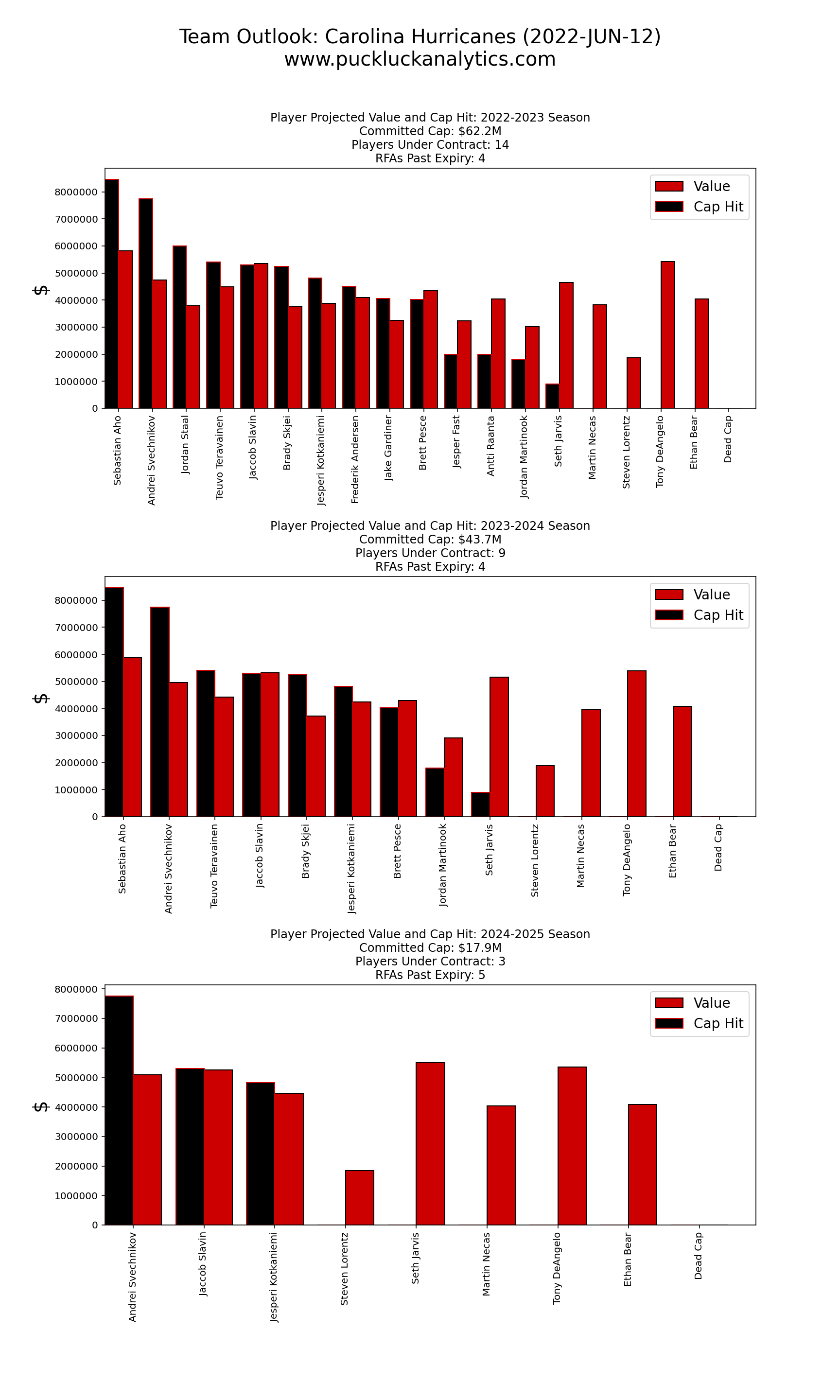
Washington Capitals
The Washington Capitals core is getting older, but they continue to be a factor in the Metropolitan every year. Their roster profile for next season suggests more of the same, with a balanced roster showing no real weaknesses. Taking a balanced approach to improving the roster this offseason looks like a suitable plan.

Unlike the Hurricanes, the Capitals do not have a lot of cap space to work with this summer. They have 15 returning NHLers, with just over $12M to fill out their roster. That gives them an average of $1.5M per contract to fill out a 23 player roster.
The Capitals only have 2 RFAs to re-sign at the NHL level this season and it’s their goaltending tandem. Finding players they can add on efficient contracts to fill out the rest of their roster will be key. They may be able to add one or two top 6 F or top 4 D, but most of their additions are likely to be depth players. If they manage their cap space well, they can improve over the offseason but it will be a tall task to keep pace with the Hurricanes.
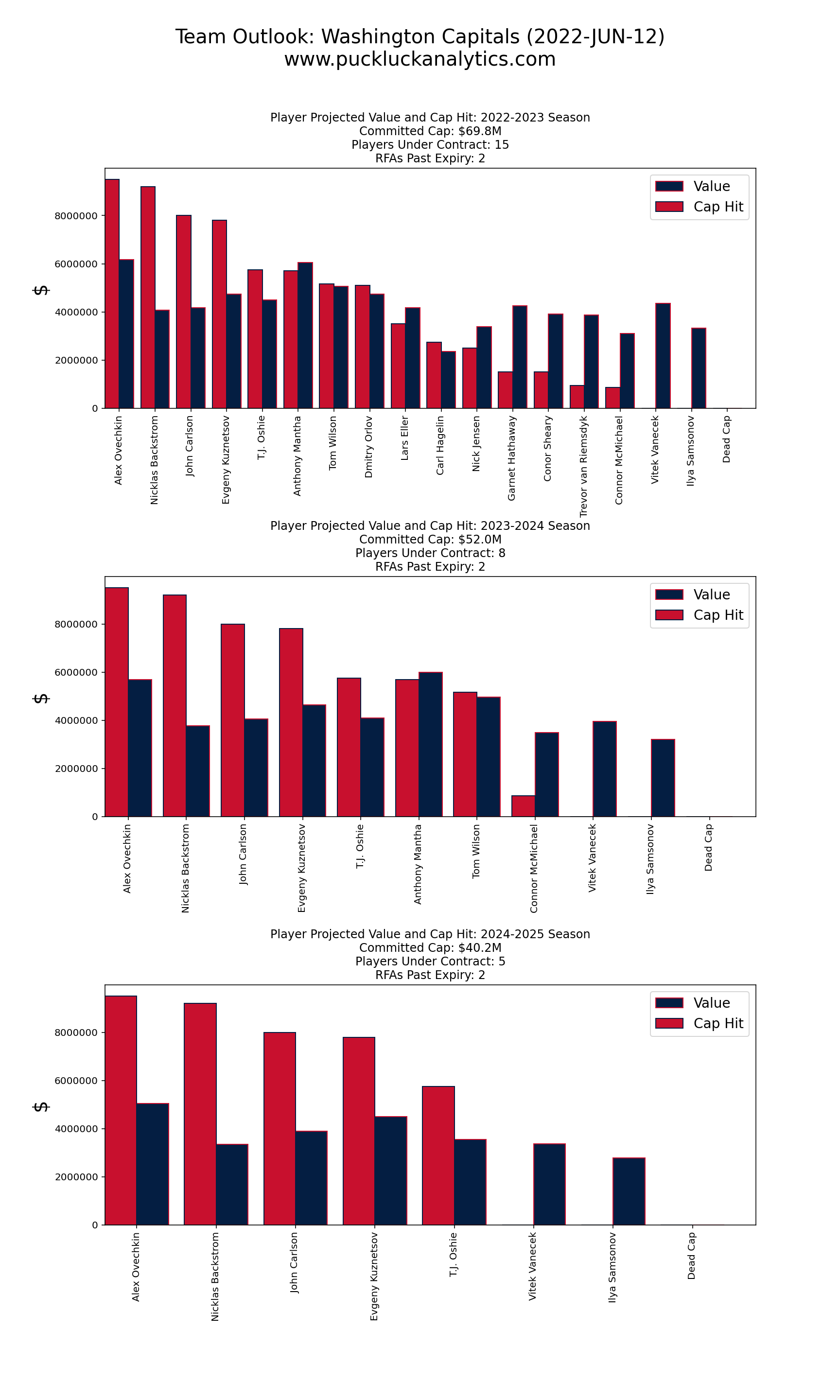
Pittsburgh Penguins
Like the Washington Capitals, the Pittsburgh Penguins have an aging core that continues to factor into the Metropolitan every year. That core may have seen it’s last run together, however, with Evgeni Malkin and Kris Letang UFAs this summer. Even without those two franchise cornerstones, the Penguins rank as playoff contenders again as the summer starts. The (potential) loss of Letang looms large as their defensive depth is a glaring weakness heading into the offseason. Mike Matheson and John Marino are very capable, but there is a steep drop off in projected impact after that.

The good news for the Penguins is that they have a lot of cap space to work with. With roughly $25M in available cap space, they have an average of nearly $2.8M per contract available to complete a 23 player roster. Their only RFAs at the NHL level are Danton Heinen and Kasperi Kapanen and it’s hard to imagine bringing them back would change that number significantly. The Penguins have the cap space to bring back Letang and Malkin if they want to and certainly have enough to make some significant improvements this summer regardless whether they re-sign their aging stars.
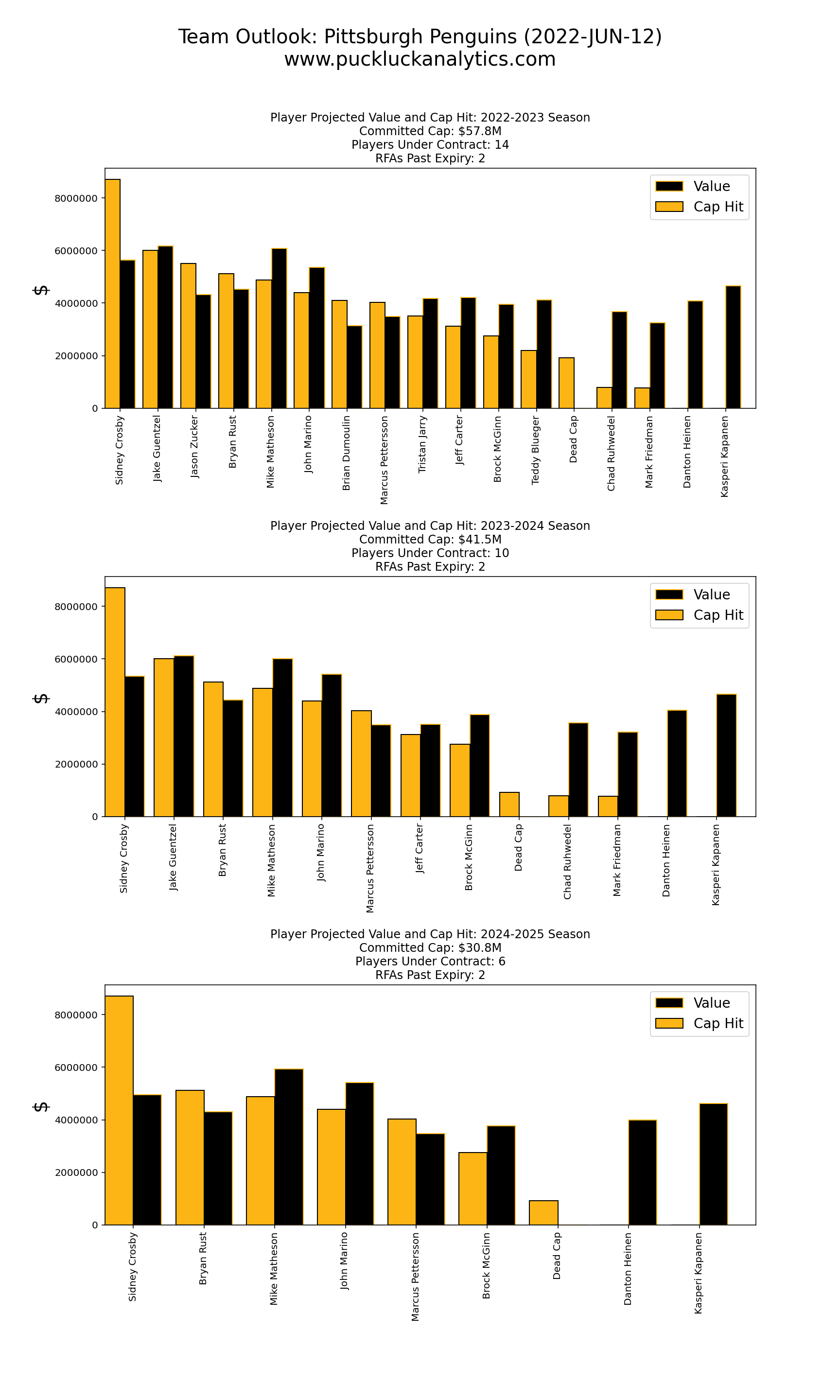
New Jersey Devils
The New Jersey Devils sufferred from some abysmal goaltending in 21/22. Goaltending aside, they looked like a much better team than their record showed and they sit in 4th spot in the Metropolitan in the early offseason projections. Goaltending remains an weakness they need to address and their defense depth could also use an upgrade this summer.
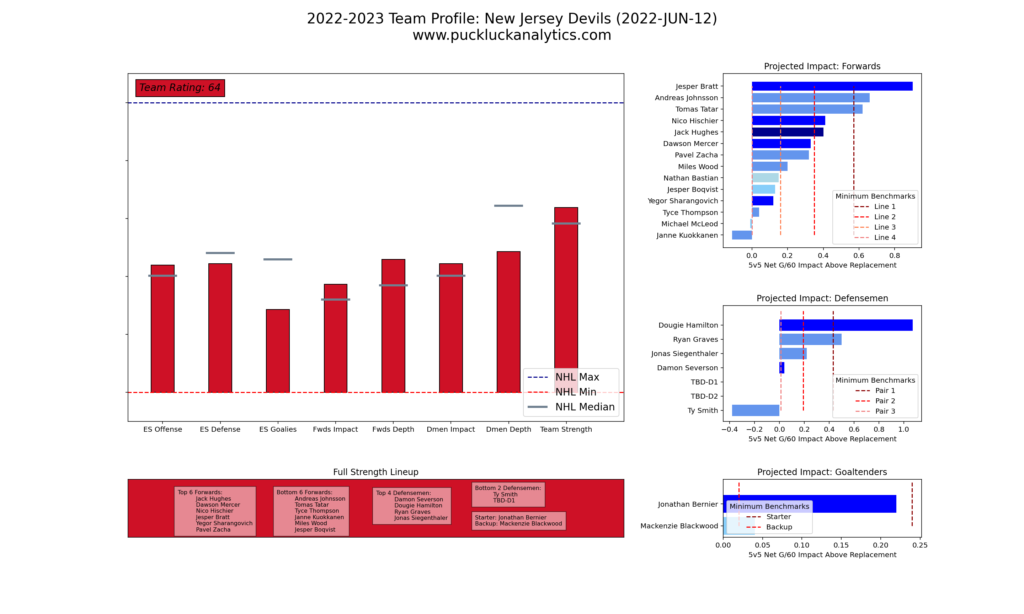
With 16 NHLers under contract for next season and $25M in cap space, the Devils have similar flexibility to the Penguins and Hurricanes entering the offseason. They do have some key RFAs to extend with the most notable being Jesper Bratt. Assuming they bring back all of their RFAs, they should still have enough cap space to prioritize adding a top 4 defenseman to solidify their blueline. A good offseason could put the Devils in position to challenge for one of the 3 automatic divisional playoff berths, although two of the three teams they’re chasing have similar offseason potential.
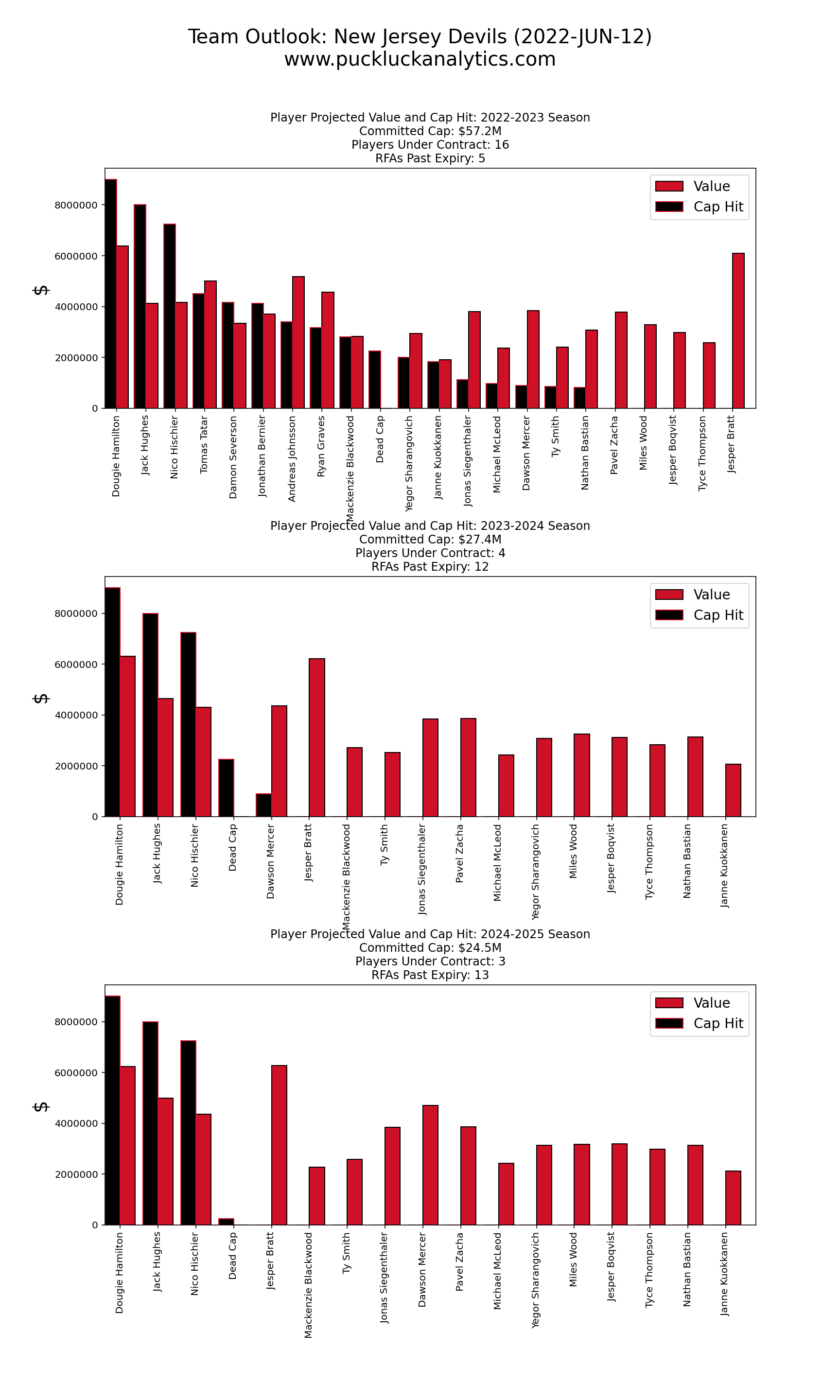
Columbus Blue Jackets
The Columbus Blue Jackets also find themselves relatively close behind the division leaders in the early offseason projections. They rank near average in a number of roster profile categories, but have a couple areas of big concern. Their even strength defense and forwards impact are major deficits that they need to address this offseason if they hope to compete for a playoff spot.
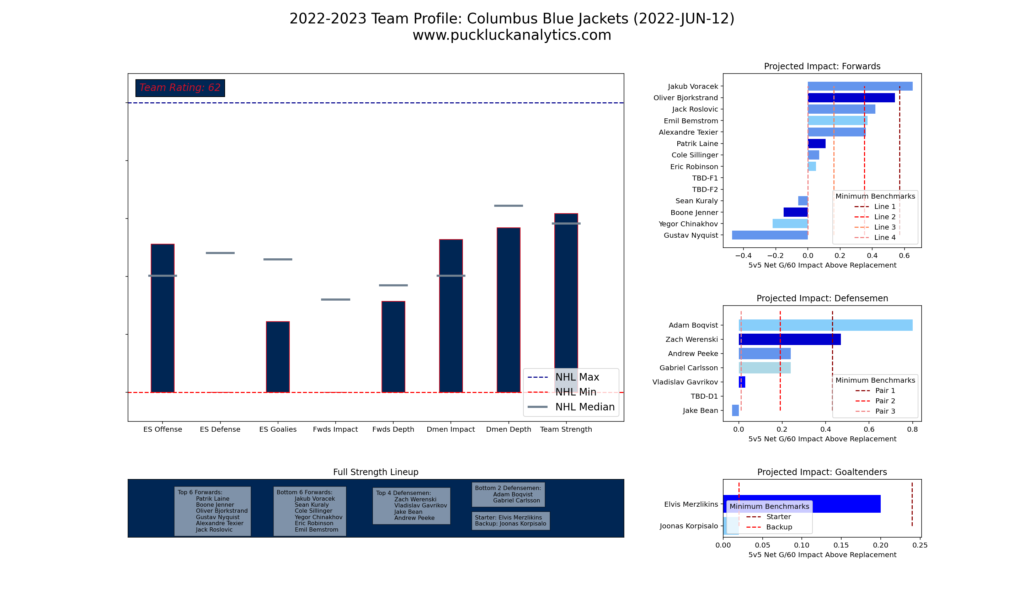
The Blue Jackets have 16 returning NHLers under contract for next season after recently extending Jack Roslovic. They have about $25M in available cap space for 7 remaining roster positions. Adam Boqvist and Patrik Laine are both RFAs and resigning them both will take a chunk out of that cap space. If they use the remaining cap space wisely, they should be able to patch up the major holes in their roster profile and ice a competitive team for the 22/23 season.

New York Islanders
The New York Islanders plummeted down the Metropolitan Division depth chart in 21/22. After reaching the Eastern Conference Final in back-to-back seasons, the Islanders crashed out of the playoff picture this season. Known for their strong team defense in recent seasons, it was a problem in 21/22 as they finished well below average in 5v5 xGA/60. With the current roster profile, it’s an area of concern heading into next season, although their even strength offense is also sub-par.
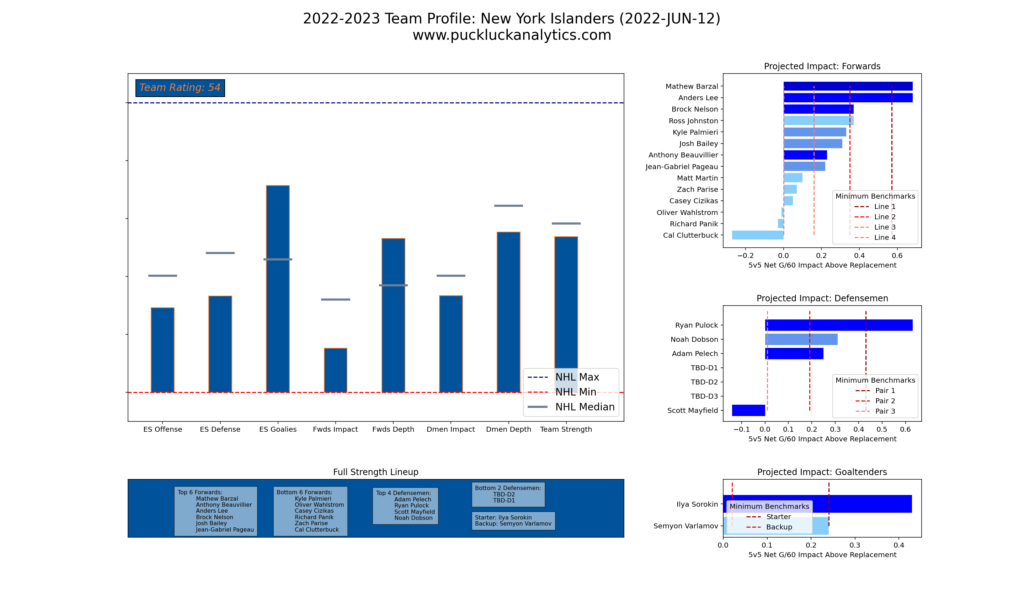
The Islanders will backed themselves into the proverbial corner, with little flexibility as the offseason gets underway. They have only about $10M in cap space to sign four players. The Isles will have to be frugal with their spending as they work on extending RFA Noah Dobson and add three more players. It will be very difficult to make any significant improvements via free agency given their limited cap space, so they may have to look to the trade market to make inroads. That may be a tall task as well, as the Islanders roster is full of contracts with lower projected value than cap hit. With a mediocre roster and little flexibility, the Islanders look like the first contender for the division basement.
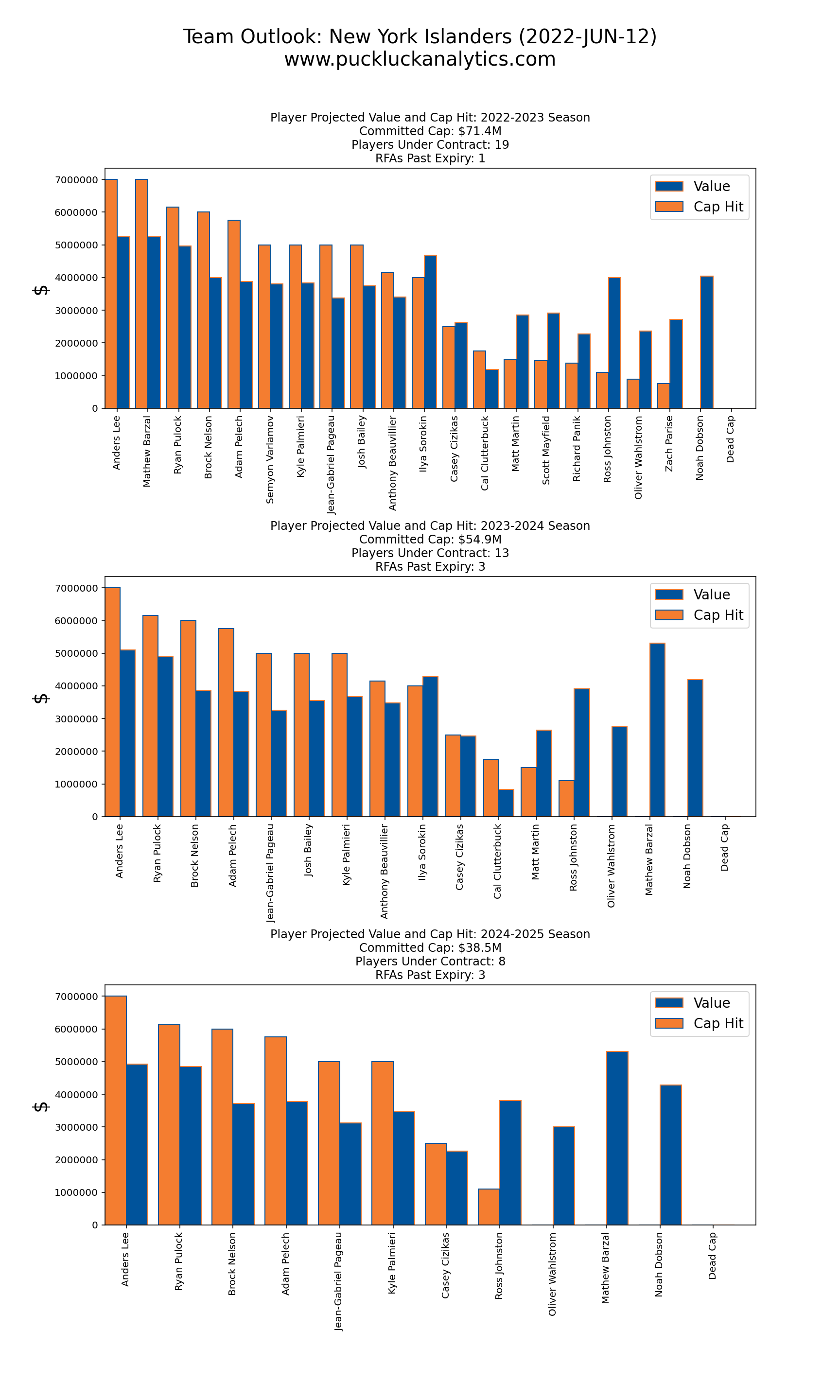
New York Rangers
The New York Rangers finished second in the division and made the Eastern Conference Final in 21/22 on the back of world-class goaltending and a strong powerplay. They struggled at 5v5, particularly offensively, and the model projects a similar fate next season. Improving their forward group by adding players that can contribute offensively at 5v5 would help the Rangers immensely heading into next season.
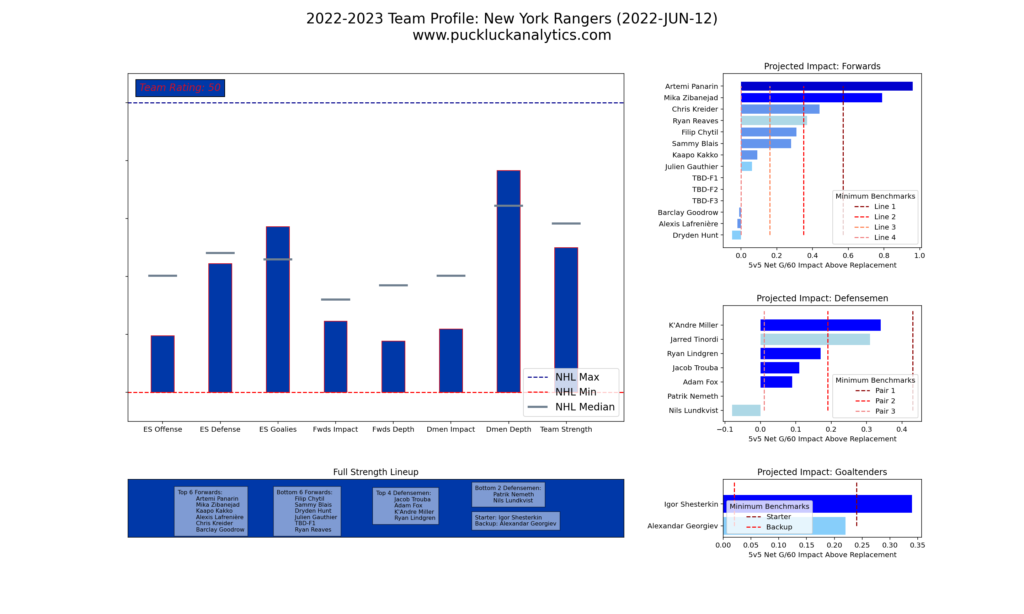
The Rangers have a few important forwards headed for unrestricted free agency this summer, which is part of the reason for the issues we saw in their roster profile. They need to replace forwards like Ryan Strome and Andrew Copp if they hope to repeat their 21/22 performance. The trouble is the limited cap space they have to accomplish that.
Kaapo Kakko, Sammy Blais and Alexander Georgiev are all RFAs and extending them all would certainly eat up much of their roughly $12M in available cap space. They’ll need to add a few players even if their RFAs all return and they’ll have to find some cap space if they hope to fill those spots with better than replacement level players. Jacob Trouba looks like an obvious choice to try to move out from a cap space perspective. Things don’t look great for the Blueshirts based on the model projections. It will take a very good offseason for the Rangers to get into the playoff battle.
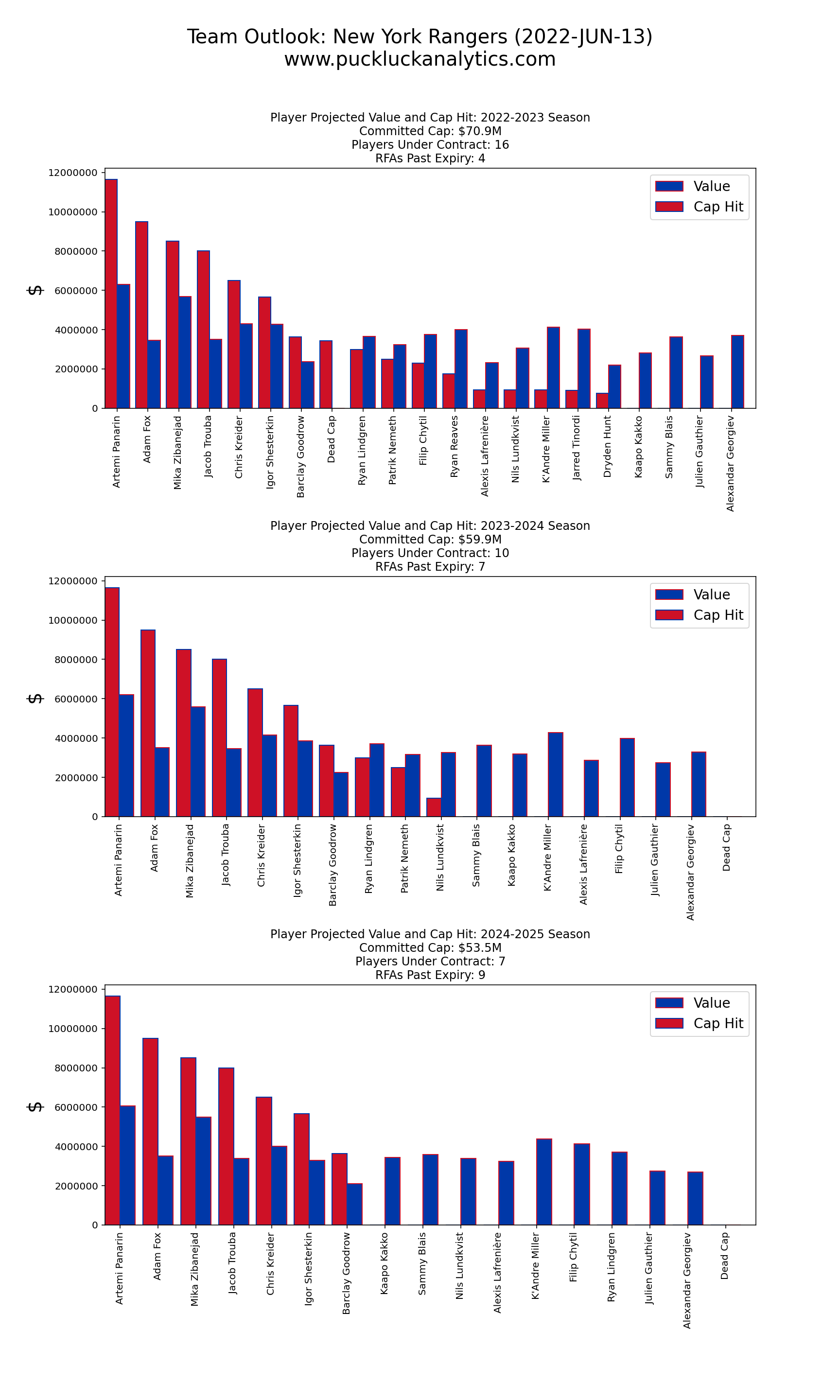
Philadelphia Flyers
The Philadelphia Flyers occupied the Metropolitan Division basement alongside the Devils last season but theirs was a much different story than New Jersey’s. The Flyers struggled across the board, putting up below average results offensively, defensively, in goal, and on special teams. Their forward depth is the one strength on their roster profile, while they need help everywhere else.
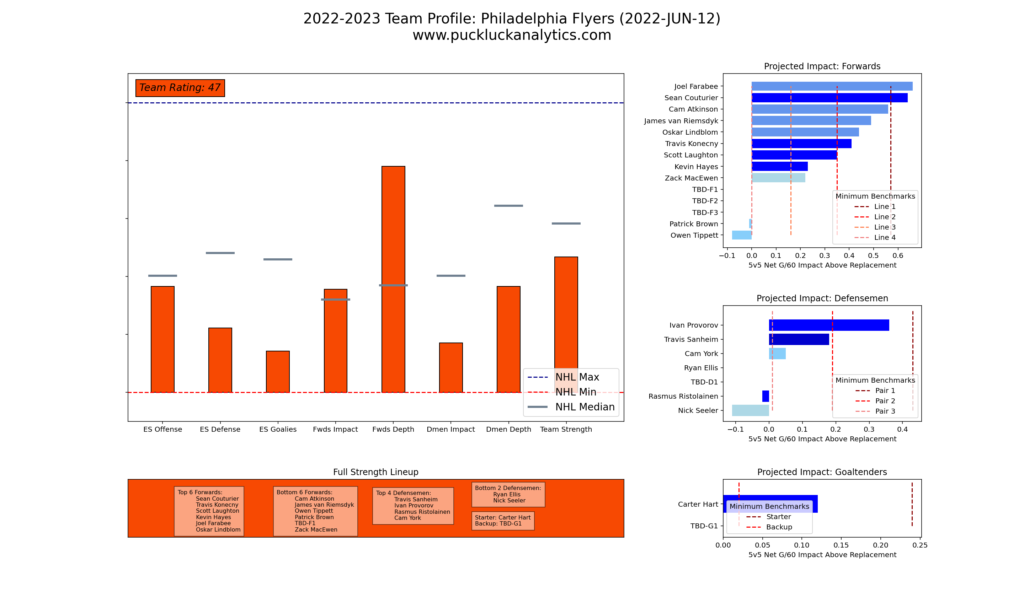
The Flyers have less than $10M in cap space to work with this offseason, even after trading longtime captain Claude Giroux at the deadline. With a highly touted draft class slated for the 2023 offseason, the Flyers look primed to compete for draft lottery odds in 22/23.
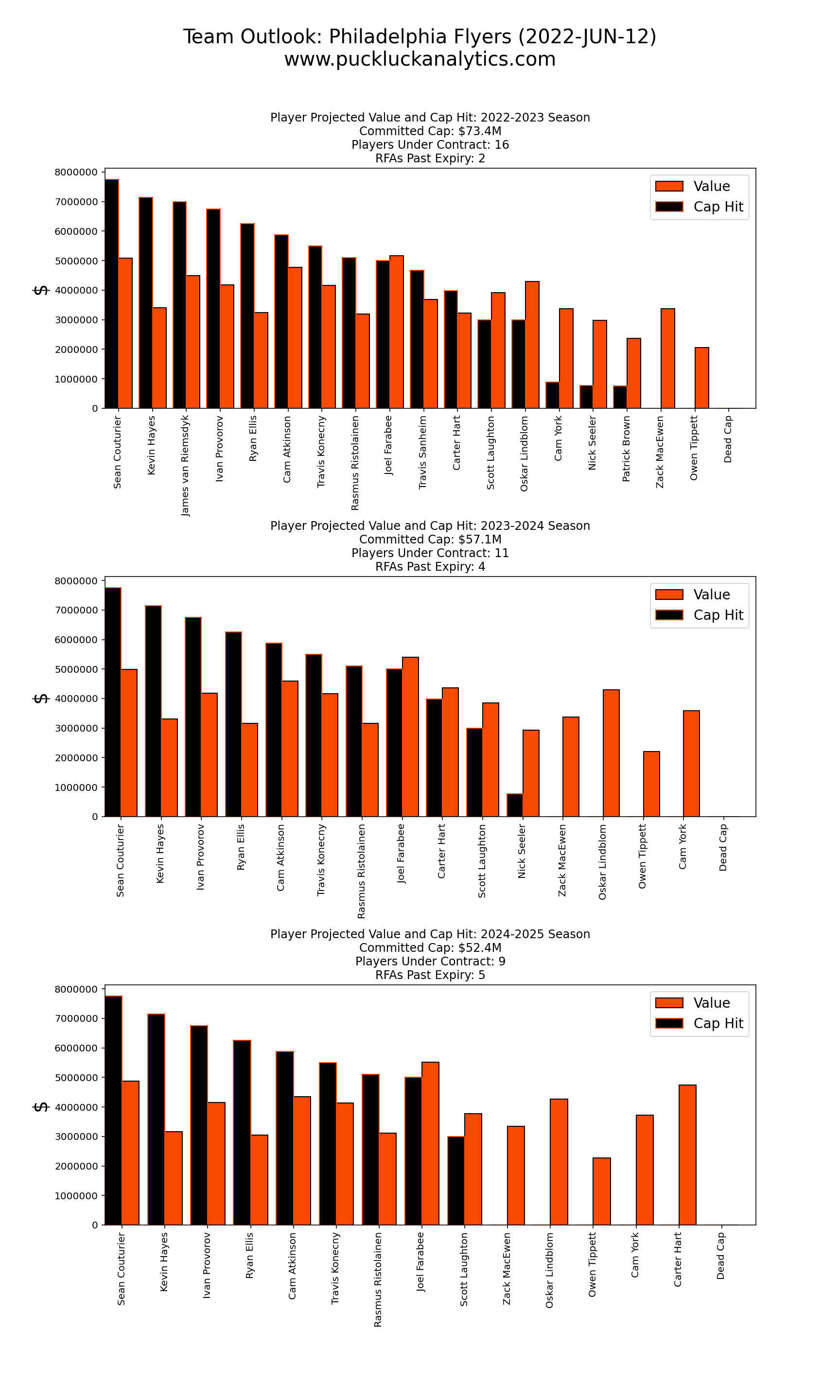
Want to peruse the player projections behind the team profiles or browse UFA player cards for the addition your favorite team needs? Sign up for an annual membership to get access to all 22/23 team and player projection cards. Plots will be updated through the offseason as the 22/23 rosters take shape and updated to track progress through the season so you can follow along with the changing landscape.
Input data for models from Natural Stat Trick. Contract data from CapFriendly.
